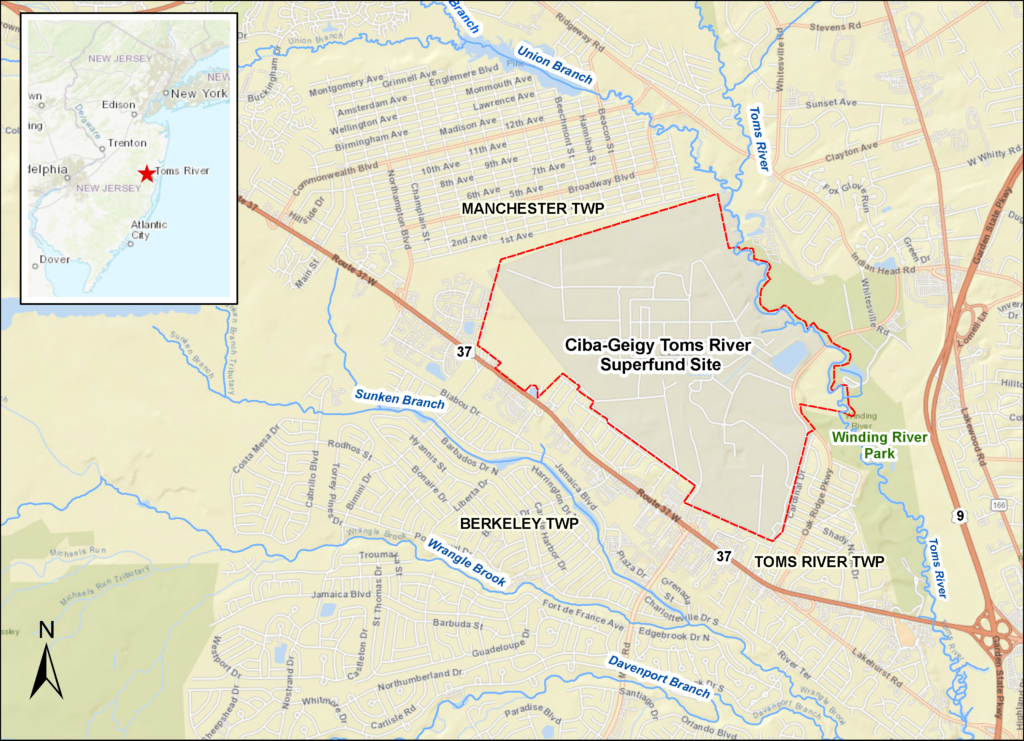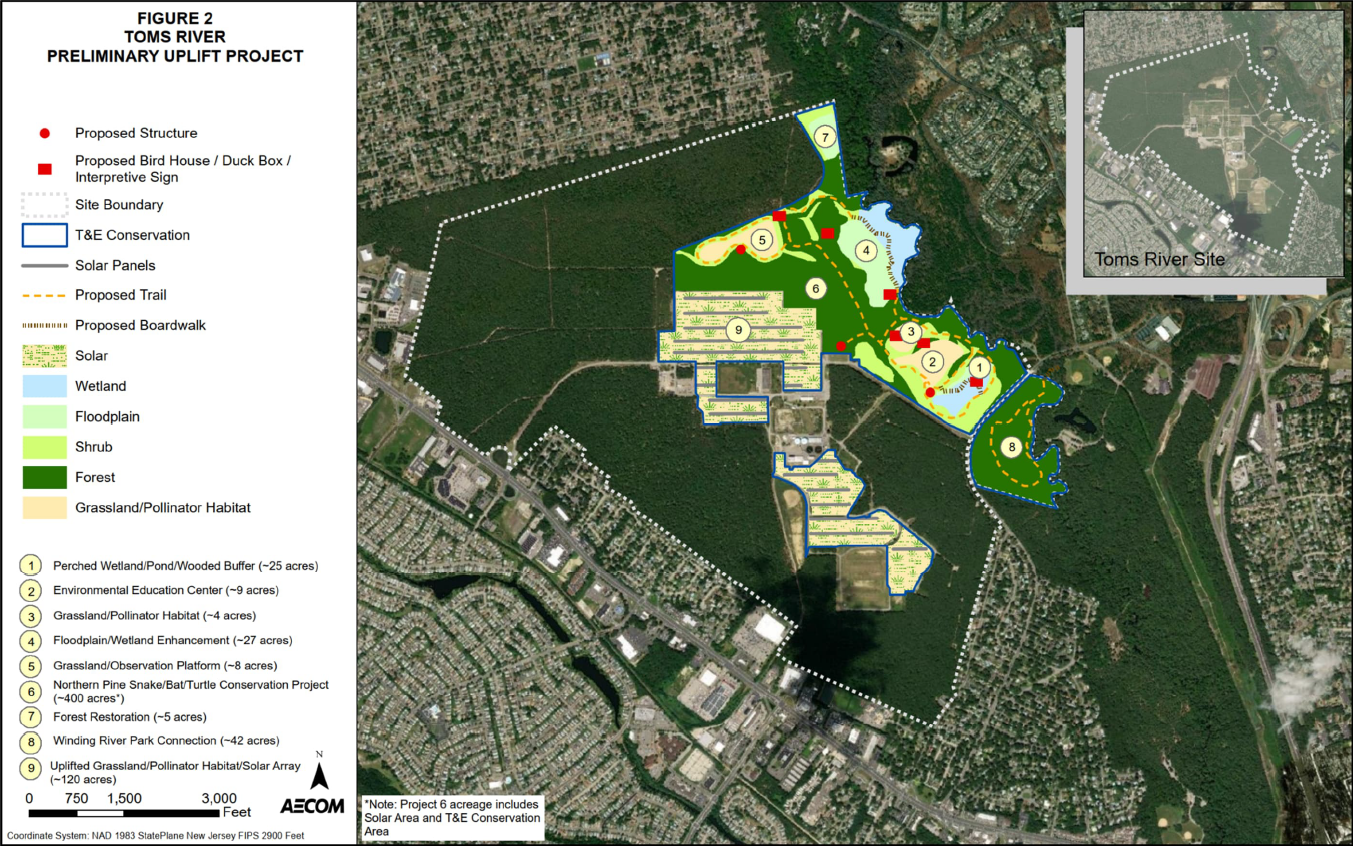
Final Agreement Executed
Executed Settlement Agreement Response to Public Comment BASF-TomsRiverNRD
UPDATE: The results of the public survey conducted by BASF are in. View the survey results.
New Jersey’s natural resources are defined as all land, fish, shellfish, wildlife, biota, air, waters, and other such resources owned, managed, held in trust or otherwise controlled by the State. As the trustee of all of the State’s natural resources, the Department of Environmental Protection (Department) has the fiduciary obligation to ensure not only the primary restoration of natural resources impacted by contamination (i.e., return of the resource to its pre-discharge condition), but also compensatory restoration, which is compensation for the lost values provided by the natural resources for the entire period the resource is not in its pre-discharge quality, quantity, function, and value.
Natural resource damages (NRD) settlements between the Department and the responsible party often secure compensation to the public in the form of restoration projects and/or land preservation. Such activities offset injuries to natural resources due to the discharge of hazardous substances by ensuring in-kind resources are restored, enhanced, and/or protected into the future. In some cases, the public may additionally benefit through access to these restored natural resources, such as where amenities are built into projects allowing for persons to interact with the natural environment. This BASF NRD settlement provides compensatory restoration and will provide access to projects upon completion.
When monetary funds are paid by responsible parties as part of an NRD settlement agreement, the funds are held in an account designated for natural resource restoration. Monetary funds recovered in a NRD settlement are legally distinct from penalties, which may or may not be warranted at a given site and would be pursued through other legal actions by the Department. A portion of the funds covers the Office of Natural Resource Restoration’s (ONRR) administrative costs associated with but not limited to the management of NRD settlements, restoration planning, construction, and oversight. In the Department’s NRD Settlement Agreement with BASF, a $500,000 payment referenced in the agreement is intended to fund the past and future oversight costs incurred by ONRR to oversee all of BASF’s obligations that will enhance and restore the natural resources at this site through a series of ecological restoration projects that will be preserved in perpetuity. Consistent with New Jersey law and other NRD settlements reached by the Department, the NRD Settlement Agreement with BASF cannot secure compensation for personal injuries, property damage, lost local revenue, and any other claims, but it does not preclude potential claims that may be pursued by individuals, private property owners, and local government units.
RESTORATION PROGRAM
The New Jersey Department of Environmental Protection (NJDEP) is requiring BASF Corporation to conduct multiple natural resource restoration projects to compensate the public for historic natural resource injuries at and related to the Ciba-Geigy Superfund Site in Toms River, Ocean County.
Under NJDEP’s oversight, BASF will permanently preserve approximately 1,000 acres thereby protecting groundwater resources in perpetuity and compensating the public for historic groundwater injury caused by Ciba-Geigy. In addition, to compensate the public for historic ecological injuries caused by Ciba-Geigy, BASF will fully design and implement nine natural resource restoration projects on 375 acres of the preserved land. Routine community engagement will help determine the design of the restoration projects, including the proposed environmental education center, walkways, and natural resource interpretative aids, to ensure their design promotes public awareness of natural resources benefits and enable meaningful and direct public access.
WHAT TO EXPECT
Beginning in 2023, BASF will perform initial surveys and preliminary design studies to help inform the conceptual project designs presented within the Scope of Work document found as Appendix B in the executed Settlement Agreement. Some of these projects are more complex than others. There will be a focus to move forward on completing the less complicated projects first while working in tandem on the more complex ones. The nine projects were broken up and placed into three categories based upon their level of effort below.
Following public input during the preliminary design process, feedback from the NJDEP, and preliminary design studies, select projects were refined and re-categorized into one of the three schedules based on design and permitting effort. The revised schedule is shown below.
FAST TRACK SCHEDULE
Project 2:
Grassland/Meadow Earthwork
Project 3:
Grassland Pollinator Habitat
Project 9:
Uplifted Grassland/Pollinator Habitat/Solar Array
- These projects have a straightforward and definable design/permitting process and can be relatively easy to implement.
Estimated Time to Completion:
Summer 2026
TYPICAL SCHEDULE
Project 4: Floodplain/Wetland Enhancement
Project 5:
Grassland Observation Platform
Project 6:
Northern Pine Snake, Bat, and Turtle Conservation
- These project have a more complex design process where there may be some permitting and implementation challenges.
Estimated Time to Completion:
Fall 2027
COMPLEX SCHEDULE
Project 1:
Environmental Education Center Wetlands Plantings/Education Center; and Perched Wetland/Pond/Wooded Buffer
Project 7:
Forest Restoration
Project 8:
Winding River Park Connection
- These projects are sophisticated in their design process and present some permitting challenges and implementation that will require a longer and more complex timeline.
Estimated Time to Completion:
Spring 2029
The Design Process
| Phase | Description | Key Stakeholders |
| Predesign Field Work | Key data needed to initiate the design will be gathered. The data will include topographic surveys, soil and agronomic data, survey of existing flora, hydrologic data, etc. | BASF; NJDEP |
| Initial Park Design Drawings | Develop a set of sketches using the information gathered in the field to express the thoughts of the design team and facilitate discussion during the Design Charette. | BASF |
| Design Meeting | In person workshop to review preliminary park design, solicit input from NJDEP, and ensure that NJDEP input has been incorporated into the Park Design Document | BASF; NJDEP |
| Design Team/Stakeholder Engagement | BASF will incorporate feedback from the into a conceptual design, which will be the subject of review an in-person meeting(s) to obtain broader stakeholder input. | BASF; NJDEP; Community & NGO Stakeholders |
| Park Design Package | BASF will incorporate feedback from the Design Team Meeting into a Park Design Package, which will include design drawings with enough detail to show how functional and technical requirements will be met, including handicap accessibility. Will also include plan drawings, project narrative, appropriate design calculations, outline of specifications list, analysis of environmental permitting requirements, and design and construction schedule. | BASF; NJDEP |
| Final Design Team Meeting / Park Design Package Review / Comment Period | In person workshop to review Park Design Package and ensure that design criteria and previous review comments have been correctly incorporated, and finalize Park Design Package so that Engineering Design can proceed | BASF; NJDEP |
| Environmental Permitting | Final Park Design Package will be used to support environmental permitting needs | BASF; NJDEP; USACOE |
| Draft Final Engineering Design | To include design narrative, key work plans, specifications, drawings, construction sequencing, permit approvals. This submittal is intended to ensure that the design criteria and previous review comments were correctly interpreted. | BASF; NJDEP |
| Final Engineering Design | Final design revisions in response to NJDEP comments on Draft Final Design. This submittal represents a 100% complete design, with the exception of the incorporation of any review comments resulting from the review of the submittal. The Final Engineering Design shall consist of:
| BASF; NJDEP |
| Issued for Construction Design | To include narrative, key work plans, specifications, drawings | BASF |
The 1,255-acre property is located at 277 Oak Ridge Parkway in Toms River, NJ. This was the site of the former Ciba-Geigy Corporation, a specialty chemicals business, which began chemical manufacturing operations at the Site in 1952 and included the production of industrial dyes, pigments, epoxy resins, and plastics. Production ended in 1990 and all operations ceased in 1996. The contaminated site was placed on the National Priorities List in 1983 as an Environmental Protection Agency (EPA)-lead Superfund site.
BASF Corporation acquired the Ciba-Geigy site while remedial activities were ongoing and continues these remediation efforts today. These efforts include excavation and capping of contaminated source areas and the pumping and treatment of contaminated groundwater.
All necessary measures have been and continue to be taken under an EPA-lead remediation process to ensure the site is protective of human health and the environment. This NRD settlement would not have an impact on any of BASF’s remaining remediation obligations under EPA’s lead oversight under Superfund.
Responsible parties that have discharged hazardous substances, contaminants, or other pollutants to the environment are required to investigate and remediate discharges. However, remedial actions may not fully restore injured natural resources or compensate the public for natural resource injuries. In such cases, responsible parties are liable to the people for natural resource restoration.
The Commissioner of Environmental Protection serves as the Trustee of all natural resources of the State with a fiduciary duty to the people of New Jersey to ensure that natural resource injuries are assessed, that damaged natural resources are restored, and that the public is compensated through natural resource restoration and preservation for natural resources that have been injured through a hazardous discharge. The State pursues natural resource restoration through primary restoration and/or compensatory restoration. Primary restoration returns injured natural resources back to the same quality, quantity, function, and value that existed prior to the injury. Compensatory restoration provides compensation through natural resource restoration for the period of time that natural resources remained injured. Compensation can take the form of monetary payment for natural resource restoration or preservation, land preservation, ecological restoration projects in various forms, and potentially a combination of those forms.
Wherever practicable, DEP pursues natural resource injury assessment and restoration through a voluntary collaborative process with responsible parties. Through voluntary negotiated settlements, the DEP can ensure more expedient natural resource restoration activities, providing more immediate and direct compensation to the public, and avoiding the delay, uncertainty, and expense of litigating natural resource injury claims before the courts.
With regard to the Ciba-Geigy site, BASF has voluntarily sought to settle its potential liabilities for natural resource injuries by entering into this settlement agreement with the Department.
DEP Administrative Order for Natural Resource Restoration Policy
In order to modernize the guidance, improve transparency, and enhance public engagement regarding the development and implementation of NRD assessments and compensation projects, state Commissioner of Environmental Protection Shawn M. LaTourette has issued Administrative Order 2023-08. This Administrative Order affirms the DEP’s duties as trustee for the state’s natural resources and, importantly, directs the DEP to put in place mechanisms to enhance consensus-building in the planning, design and implementation of natural resource restoration activities through improved collaboration with the public and stakeholders.



